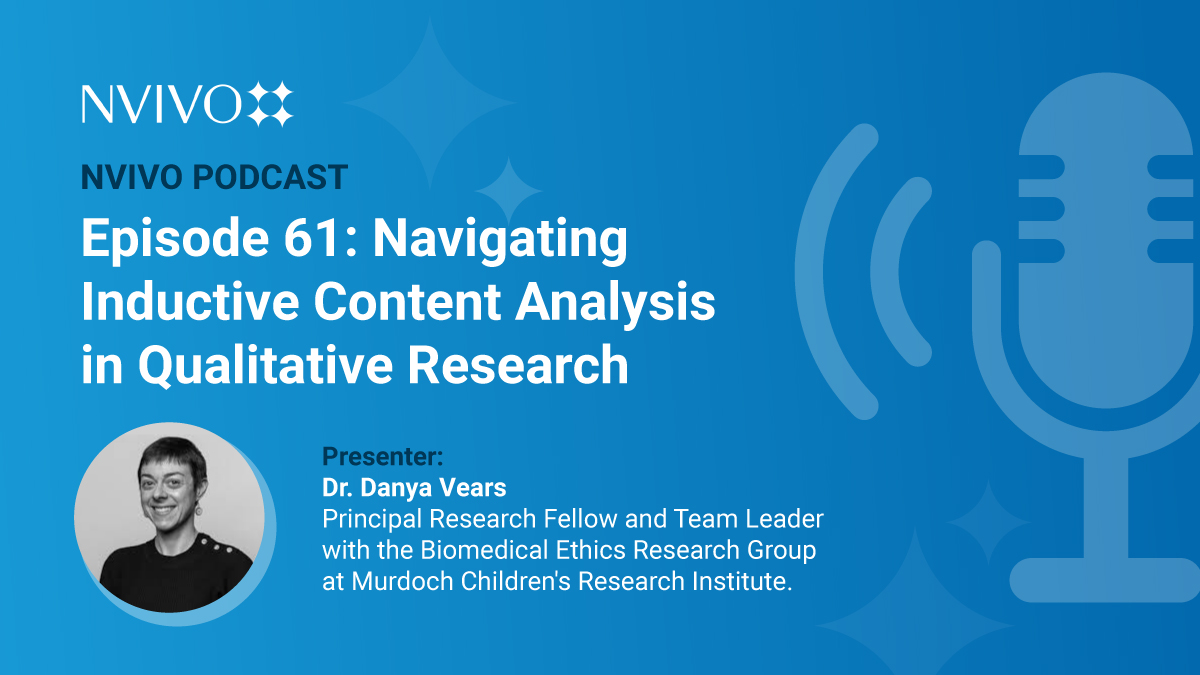
Which qualitative content analysis methods should you choose to make sense of your data? What best practices should you adopt for each method? In the latest episode of Between the Data. Dr. Stacy Penna talked to Dr. Danya Vears, Team Leader and Principal Research Fellow at the Murdoch Children’s Research Institute (MCRI) in Melbourne, Australia, about a qualitative research method she has been working with since her days as a student in biomedical ethics: inductive content analysis (ICA).
In the episode, Dr. Vears described how ICA works, discussed specific research contexts where ICA can be especially useful, and gave a step-by-step overview of the ICA process. This article offers some highlights from the episode.
What is Inductive Content Analysis, and How Does It Compare to Other Methodologies?
ICA is a qualitative content analysis method that produces a thematic summary of multiple texts by deriving categories and codes from the data. This makes it different from deductive content analysis in which a researcher develops a codebook based on a literature review, theoretical framework, or other preliminary work and then codes their data according to that predetermined list.
ICA also differs from thematic analysis, which is a close-grained, line-by-line coding process that results in a theoretical interpretation of the data. ICA begins at the higher category level, then builds out subcategories, ultimately resulting in a conceptual map.
An Often-Misunderstood Qualitative Content Analysis Method
Dr. Vears’s interest in ICA began while she was a PhD student. She and her supervisor, Professor Lynn Gillam, decided that ICA would be a good match for Vears’s research into the biomedical ethics of genetic carrier testing in children. ICA lends itself to both exploratory analysis and to research that aims to develop practical recommendations for improving services or policies.
However, the literature around ICA as a practice seemed muddled to Vears. “I started doing some research around how to do [ICA], and just found it was a bit of a mess,” she told Dr. Penna. Her investigations revealed that past researchers hadn’t settled on steps for the process — sometimes, researchers would draw in quantitative methods like counting as part of ICA. There was even a lack of agreement on what ICA should be called.
In preparing to complete her dissertation, Vears had found a new parallel interest: contributing to a better understanding of ICA as a methodology. “I just felt like we needed to do something to help junior researchers to figure out how to do this better.”
An Overview of the Inductive Content Analysis Process
Dr. Vears walked Penna through the basics of ICA. The first step, she explained, is to read and familiarize yourself with the texts you will analyze. “It’s particularly important if you haven’t actually collected that data yourself,” she notes. She says she often cautions researchers who are new to ICA to stay close to the data and not fall into the trap of over-extrapolating or interpreting themes as they go.
Next is to conduct a first round of coding that identifies high-level categories, or “big-picture meaning units” as Dr. Vears puts it. In a project based on interviews, for example, these categories will often relate
to the topics of each question. The coded sections in this initial round will usually be larger pieces of text — whole paragraphs or more.
The next step is to carry out a second round of coding that breaks each category down into even further fine-grain topics. If necessary, researchers can complete additional rounds of coding after this. The final step is to produce a map of the categories and concepts from across all the texts — one that can be used to draw conclusions about the whole body of research.
Dr. Vears likened the ICA process to drawing a road map: first you draw in the main roads, then the secondary roads, and finally the side streets.
Developing an ICA Map with Qualitative Research Software
Another advantage of ICA, according to Vears, is that it doesn’t necessarily require a particular technology. “You can do it on paper that you print out if you want to,” she says. But she also notes that she and her students have found NVivo to be a useful tool for ICA and for qualitative content analysis in general.
NVivo accommodates multiple rounds of coding well and makes developing categories and subcategories a simpler, more intuitive process. Plus, NVivo makes it possible to create visual representations of code hierarchies that can be used for collaboration across research teams or for presentations of data. One option with NVivo is to use the autocoding feature during the first pass of your coding which automatically detects and codes themes – saving you significant time.
Spreading the Word about ICA
Dr. Vears has become the go-to expert on using ICA in qualitative research at MCRI. She’s helped students and colleagues understand its applications in their research and conducted seminars on best practices. In 2022, she and Dr. Gillam published a paper, “Inductive Content Analysis: A Guide for Beginning Qualitative Researchers”.
She’s had a good response to the paper, with researchers from as far afield as Portugal asking her for more advice on ICA. Now, Dr. Vears is considering developing additional training resources to help others benefit from the methodology she’d struggled to find a good definition for as a PhD student — a methodology that has been so useful throughout her career.
Want to hear more about Dr. Vears’s thoughts on inductive content analysis and some specific examples of how she’s used it in her work at MCRI? Learn more about this research: listen to the full podcast episode here.

